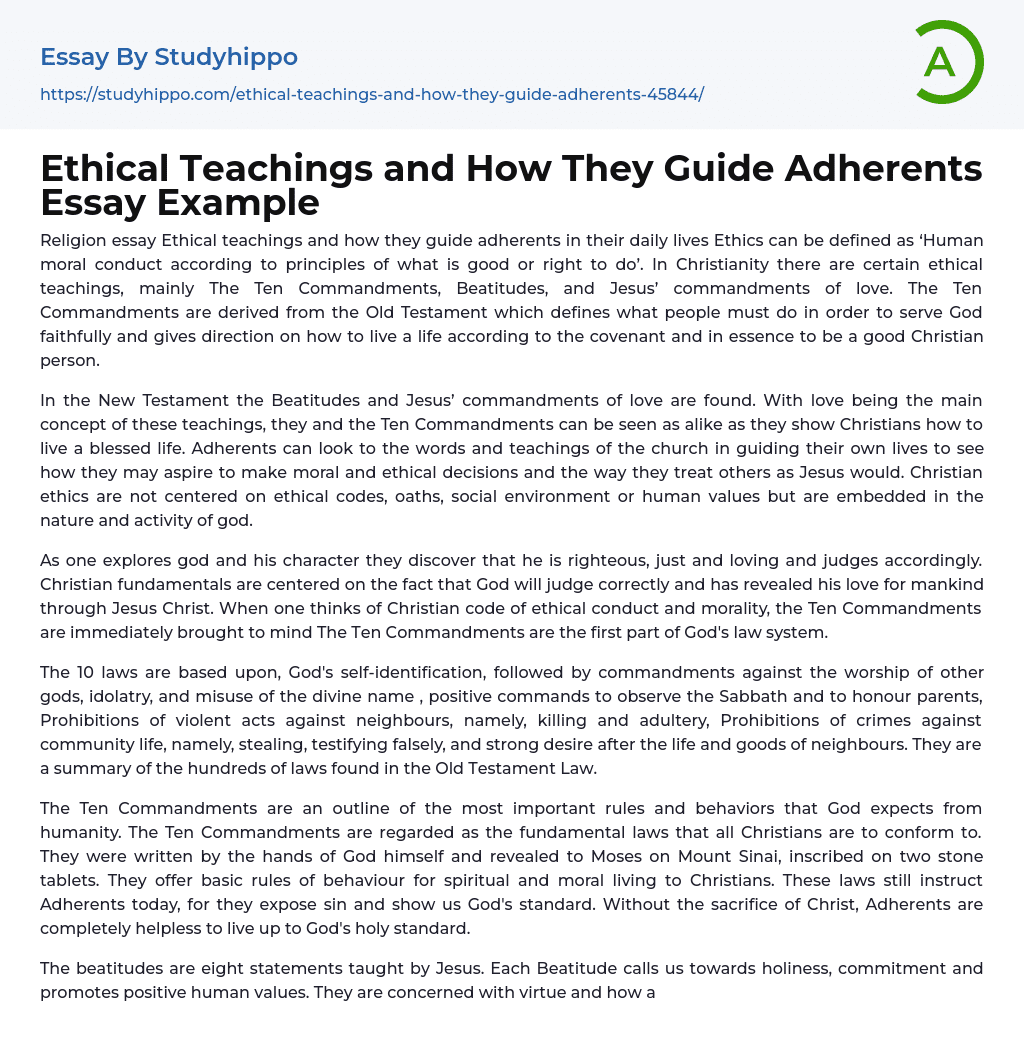

Ethical Teachings and How They Guide Adherents Essay Example
Religion essay Ethical teachings and how they guide adherents in their daily lives Ethics can be defined as ‘Human moral conduct according to principles of what is good or right to do’. In Christianity there are certain ethical teachings, mainly The Ten Commandments, Beatitudes, and Jesus’ commandments of love. The Ten Commandments are derived from the Old Testament which defines what people must do in order to serve God faithfully and gives direction on how to live a life according to the covenant and in essence to be a good Christian person.
In the New Testament the Beatitudes and Jesus’ commandments of love are found. With love being the main concept of these teachings, they and the Ten Commandments can be seen as alike as they show Christians how to live a blessed life. Adherents can look
...to the words and teachings of the church in guiding their own lives to see how they may aspire to make moral and ethical decisions and the way they treat others as Jesus would. Christian ethics are not centered on ethical codes, oaths, social environment or human values but are embedded in the nature and activity of god.
As one explores god and his character they discover that he is righteous, just and loving and judges accordingly. Christian fundamentals are centered on the fact that God will judge correctly and has revealed his love for mankind through Jesus Christ. When one thinks of Christian code of ethical conduct and morality, the Ten Commandments are immediately brought to mind The Ten Commandments are the first part of God's law system.
The 10 laws are based upon, God's self-identification
followed by commandments against the worship of other gods, idolatry, and misuse of the divine name , positive commands to observe the Sabbath and to honour parents, Prohibitions of violent acts against neighbours, namely, killing and adultery, Prohibitions of crimes against community life, namely, stealing, testifying falsely, and strong desire after the life and goods of neighbours. They are a summary of the hundreds of laws found in the Old Testament Law.
The Ten Commandments are an outline of the most important rules and behaviors that God expects from humanity. The Ten Commandments are regarded as the fundamental laws that all Christians are to conform to. They were written by the hands of God himself and revealed to Moses on Mount Sinai, inscribed on two stone tablets. They offer basic rules of behaviour for spiritual and moral living to Christians. These laws still instruct Adherents today, for they expose sin and show us God's standard. Without the sacrifice of Christ, Adherents are completely helpless to live up to God's holy standard.
The beatitudes are eight statements taught by Jesus. Each Beatitude calls us towards holiness, commitment and promotes positive human values. They are concerned with virtue and how a believer in Jesus Christ can achieve that virtue. The Beatitudes are a map of life, a series of directives helping us on our journey to be with God. They are simply stated, but are profound in meaning. They guide, point and teach. In the Beatitudes, Jesus taught his followers how to let love reign the world, and when love overcomes all other things there will be a state of peace.
They show Adherents the values that
Christ cares about. These values if followed can not only bring a believer into a state of peace and happiness, but also right into the Kingdom of God after our journey on this earth is over. Teachings of the Beatitudes can apply to our lives today as they are timeless in teaching and ‘confronting us with decisive choices concerning earthly goods, they purify our hearts in order to teach us to love God above all things’ (Catechism of the Catholic Church 1725-1728).
- Values of Life essays
- Ethical dilemma essays
- Normative Ethics essays
- Virtue Ethics essays
- Belief essays
- Deontology essays
- Moral essays
- Virtue essays
- Work Ethic essays
- Acceptance essays
- Age Of Enlightenment essays
- Child Observation essays
- Confucianism essays
- Conscience essays
- Critical Reflection essays
- Destiny essays
- Determinism essays
- Empiricism essays
- Environmentalism essays
- Epistemology essays
- Ethics essays
- Ethos essays
- Existence essays
- Existentialism essays
- Fate essays
- Free Will essays
- Functionalism essays
- Future essays
- Good And Evil essays
- Human Nature essays
- Individualism essays
- Meaning Of Life essays
- Metaphysics essays
- Natural Law essays
- Personal Philosophy essays
- Philosophers essays
- Philosophy Of Life essays
- Political Philosophy essays
- Pragmatism essays
- Reality essays
- Relativism essays
- Teaching Philosophy essays
- Time essays
- Transcendentalism essays
- Truth essays
- Utilitarianism essays
- Adam And Eve essays
- Baptism essays
- Catholic Church essays
- Christian essays



